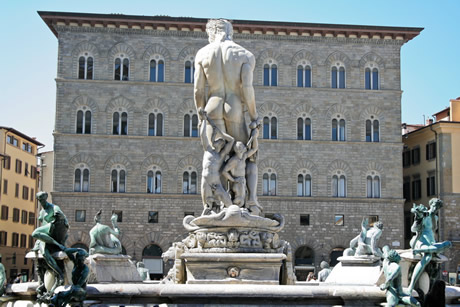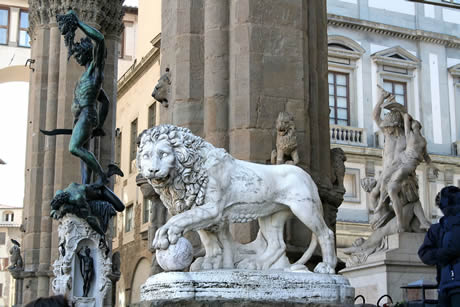Piazza della Signoria

Florence can roughly be divided into several piazzas which stand out as main tourist hotspots by force of the objectives they amass, objectives which, at their turn, are yielded either by museums, art galleries and religious establishments or by palazzos and other historic edifices and landmarks. The famed Piazza del Duomo is, by far, the most significant from this point of view, given it is towered by four of the most notorious attractions, namely, the Cathedral of Santa Maria dei Fiori, the adjoining Baptistery of St. John and Campanile, as well as by the Cathedral Museum. Yet, there is a plethora of other piazzas in Florence managing to complement the tourist offer put forward by the capital of Tuscany either by the artistic, historic, religious and cultural heritage they cluster or by the shopping and leisure opportunities they make available to the satisfaction of all tourists. The following is but a selection of the most significant piazzas in Florence.
Unlike the nearby Piazza del Duomo which can rightfully be considered the hub of religious establishments of Florence, Piazza della Signoria has long been the political center of the capital of Tuscany, more precisely, as from the 14th century, though relatively recent archeological findings substantiate its chiefdom as political force from the Antiquity. The bottom line is the political profile of Piazza della Signoria has always been paralleled by a certain penchant of the Florentines for marking their political achievements with artistic masterpieces – mainly architectural and sculptural – which is why the piazza in question has gained the statute of open air art gallery. And, indeed, landmarks such as the Palazzo Vecchio (also referred to as Palazzo della Signoria, which means it is the very landmark which gives the name of the Piazza) and Loggia dei Lanzi justify this perspective on Piazza della Signoria. Pallazo Vecchio (the Old Palace) hosts the nowadays City Hall of Florence and it strikes by its fortress-like look with its crenellated roof and imposing clock tower.

Regardless of the outer architectural merits, the three-courtyard Palazzo Vecchio is an invaluable artistic mine being populated by an impressive amount of architectural, sculptural and pictorial masterpieces owed to Simone Pollaiolo, Vasari, Verrocchio, Ridolfo del Ghirlandaio, Giuliano da Maiano, though Michelangelo and Leonardo da Vinci alike have been required to share in to the embellishment of the place, which they unfortunately failed. Loggia dei Lanzi borders one corner of Piazza della Signoria, and it actually consists of a splendid array of Renaissance arches sustained by majestic columns featuring Corinthian capitals. Simone di Francesco and Bernardo Buontalenti are the main architects of this Loggia, and its worth was ascertained by Michelangelo himself who suggested that the Loggia should be extended such as to surround the entire Piazza della Signoria. The Loggia is populated by several sculptural masterpieces, such as Perseus with the Head of Medusa (pertaining to Benvenuto Cellini) and the Rape of the Sabine Women (by Giambologna), the Rape of Polyxena and Menelaus Supporting the Body of Patroclus.

The Uffizi Gallery and Palace, a genuine artistic gem of Florence, as well as the Palazzo Pitti, though not precisely located within Piazza della Signoria, are in close proximity to it (southwards from Piazza della Signoria), whereas Palazzo del Bargello with its Bargello National Museum is only few minutes northwards from the respective piazza, enhancing the artistic rating of this tourist hotspot. Orsanmichele, as well as the Palazzo Pazzi and Dante’s House can be cited as nearby attractions. Yet, another beautifully painted landmark in Piazza della Signoria is the Tribunal of Merchandise (Tribunale della Mercanzia), whereas the sculptural asset of the piazza is complemented by a copy of the famous marble David, the original (owed to Michelangelo) being now sheltered in the gallery of the Academy of Fine Arts, by another masterpiece of Giambologna, that is, the bronze sculptural group of Cosimo I and his horse, not to mention Bartolomeo Ammannati’s Fountain of Neptune right in front of the Palazzo Vecchio. The Palazzo Uguccioni, allegedly conceived either by Michelangelo or by Raffaello, can also be spotted in Piazza della Signoria.